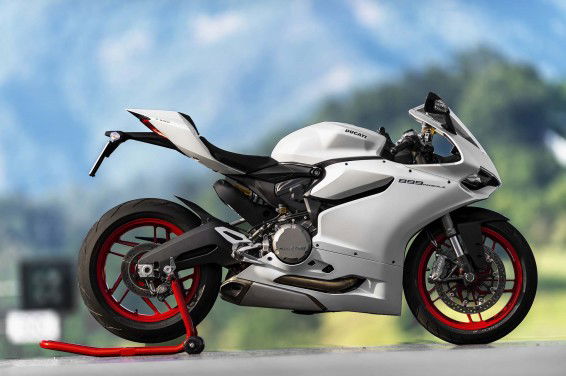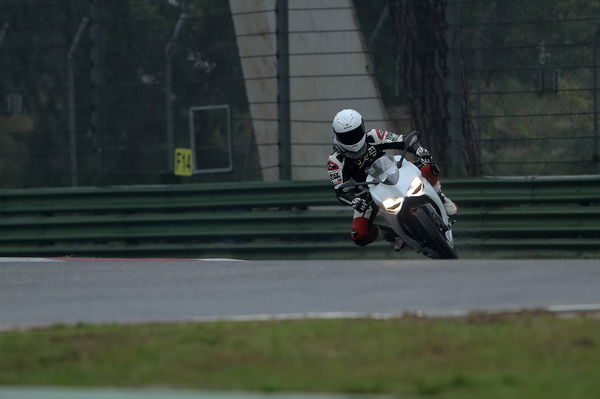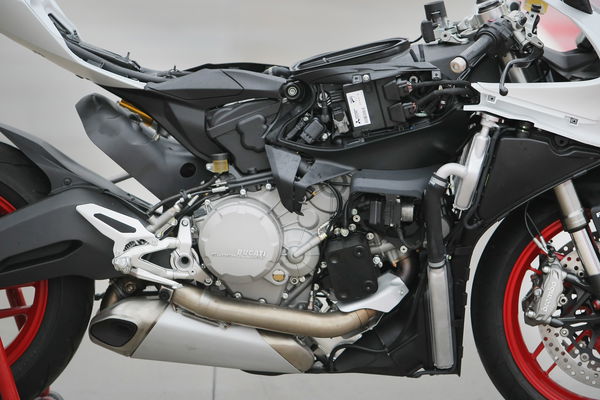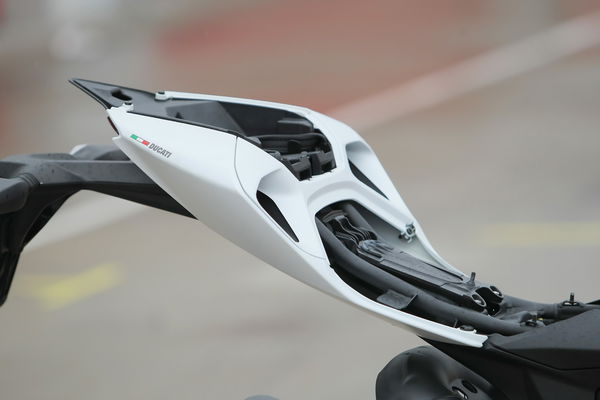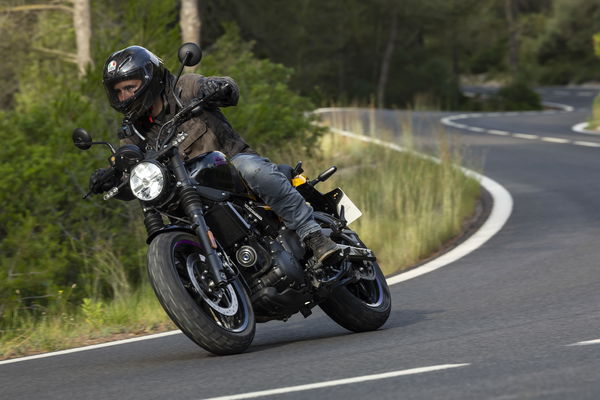Ducati 899 Panigale (2014) review
Can the Ducati 899 Panigale really be called a 'baby' superbike? We reveal the Visordown verdict in this review.
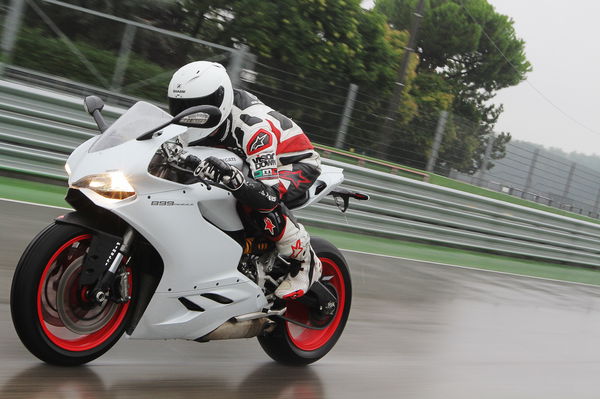

Ducati 899 Panigale: Design
The script has been the same for years: Big new Ducati superbike enters the fray setting pulses racing. Just as the commotion starts to die down, a smaller version slides in and once again, hearts start to flutter.
That’s the plotline Ducati has written for the last two decades but no matter how predictable, the story never gets old.
The 899 Panigale takes over from the popular 848, the baby superbike in Ducati’s range. Even though the new 899 Panigale is small compared to the big 1199 Panigale, it’s just 18cc shy of the original 916. Can you still call it a ‘baby superbike’?
In fact Ducati call the new 899 a ‘supermid’, which may sound like hollow marketing jargon but with a claimed 148bhp and 73lbft of torque, it’s definitely not a bike aimed at the novice. Ducati have taken the style of the 1199 Panigale and, with an 898cc engine, made it more accessible.
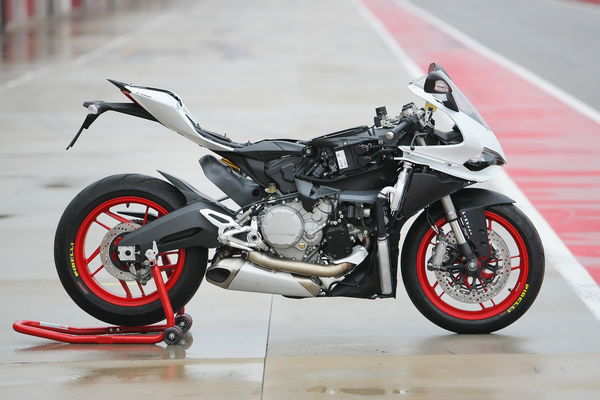
They claim the 899 is a jack of all trades; as much a road bike as a track-focused bike, a bike that uses technology to make it more accessible and at the same time, a bike that supersport riders can aspire to but also a bike that could tempt current superbike owners too.
Is the 899 an 1199 with a small engine and a double-sided swingarm? Well, yes and no.
The 899 shares the same monocoque aluminium frame as the 1199. The crankcases are the same as the 1199 and just with those two elements, you essentially have the same core as the 1199. However the 899’s Superquadro bore and stroke are 100mm x 57.2mm (compared to the 1199’s 112mm x 60.8mm). The 899 features redesigned intake and exhausts ports, a different cam profile, smaller valves than those on the 1199 but larger than those on the 848 Evo. The clutch cover, cylinder head and sump cover are all aluminium instead of the magnesium used on the 1199.
The double-sided swingarm is shorter, lighter and stiffer than the single-sided version on the 1199. The 899’s wheelbase is 1436mm, 11mm shorter than the 1199. The tank is steel, not aluminium but it’s 1kg lighter than the plastic tank on the 848. The subframe is steel and not cast aluminium. The suspension is one area where I think the 899 holds it own against the 1199 Panigale as it features fully-adjustable Showa Big Piston forks over the 1199’s fully adjustable Marzocchi conventional forks. The rear suspension is a fully-adjustable Sachs unit and a Sach steering damper is fitted as standard.
Other changes include an all-new LCD display, instead of the TFT full-colour version on the 1199. The rear wheel is obviously not the same as the 1199's and the 899 doesn’t feature the LED headlights fitted to its bigger, older brother.
Ducati 899 Panigale: Performance
The brakes are Brembo Monobloc, just like on the 1199 except the pistons are 32mm in diameter compared to the 50mm. As on the 1199, Ducati Traction Control and their DQS quickshifter come as standard but the 899 also features ABS in the Ducati Safety Pack as standard - it’s an option on the 1199.
There’s no slipper clutch on the 899 and that’s the only cost-cutting measure I can see that could affect performance. All the other changes appear logical. Does anyone really care if the subframe is made from welded steel and not cast aluminium? Are you seething at the lack of full-colour display, red-faced over the aluminium engine covers that once were magnesium? I didn’t think so. In fact, it makes me wonder how much cheaper a base-model 1199 Panigale would be if it followed the same measures. But that’s a story for another day.
The riding position is the same as the the 1199 but arguably less extreme than on the 848. The bars are set 10mm higher than the 848's while the seat is set 30mm closer to the bars. The seat height is 830mm compared to the 1199’s 825mm but that’s down to an additional 5mm of padding in the seat, aimed at making it more comfortable. I'm 5'11" and had no problems when it came to comfort.
The 899 is 5kg heavier than the 1199, which might make you think ‘wow, it’s heavy’ but the 1199 is an incredibly light motorcycle. If you look at it another way, the 899 is 5kg lighter than an 848 Evo and that’s with the 899 carrying ABS. No-one ever accused the 187kg 848 Evo of being heavy. The 899, at 182kg, is a tight package.
I raced an 848 for a couple of seasons and got to know the bike well. The 899 looks a lot smaller, the under-seat exhausts of the 848 help to elongate its profile, whereas on the 899, the meat of the bike is well and truly focused around the engine. The tank on the 899 doesn’t feel as long nor as tall. You feel like you sit in an 848 whereas I feel like I sit on the 899.
The engine responds the instant you tweak the throttle and the revs jump with no apparent resistance. The exhaust fires out a rat-tat-tat like a burst of fire from a machine gun. This is no lumbering V-twin.
It has been raining hard for two days - it’s so wet here at Imola that you’d probably set a faster laptime in a canoe. Nevertheless, we head out on Pirelli Diablo Rain tyres, the wets you’d see on a the World Superbike grid and suspension settings that have been softened to suit the conditions. We’ve also got the bikes in the Wet riding mode, which limits power to 110bhp, softens off the throttle map and turns up the sensitivity of the ABS and traction control.
For road riding, I can see the benefit of the Wet mode but on track, the system is so sensitive, it completely restricts anything the bike wants to do, just as it wants to do it. Driving out of corners, just as the motor starts to pick-up at 7,000rpm, the traction control light goes from a wild flicker to an almost constant and you feel the engine being held back.
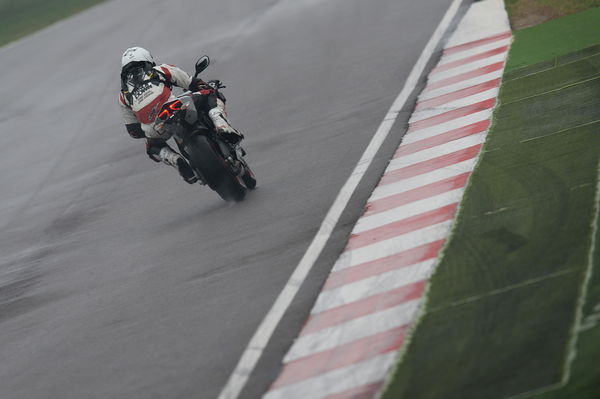
You would have to try hard to crash an 899 in Wet mode. It won’t allow the rear wheel to move, even if poked with a sharp tweak of the throttle. You can feel your input blunted as the inigition flattens and the rear tyre regains grip.
What you can’t squeeze out of corners, you can make up by squeezing in. The front-end feels light and plush. I love big piston forks but some riders don’t get on with them in the wet. Imola has many different Tarmac surfaces, some of them dating back to 1784 but despite there being obviously visible changes in surface and texture, the BPF forks filter out the noise and keep the feedback clear, uncluttered.
The profile and compositon of the Pirelli Diablo Rain tyres obviously change handling compared to standard but the 899 doesn’t require much effort to get it into corners. The 848’s steering feels lazy and the bike sits flat in standard trim but the 899 feels lighter and more eager to turn.
In Sport mode the 899 feels like a complete bike. The motor punts out its maximum power and while the ABS settings are almost identical to Wet mode, the traction control level is backed off, from eight to five. It’s the additional power, more than the minimized traction control, that makes the difference.
Ducati 899 Panigale: Engine
It’s a glorious engine. Considering the 899 is running a standard air-filter and road-legal exhausts, it’s amazing how free-revving the 899 lump is. On track, you won’t dip much below 6,000 and after 7,000rpm things really start to move. The engine is fast-revving, it’s eager and the throttle response is light but not numb, like some ride-by-wire systems can be.
Even in these conditions, the eight-stage traction control setting, set at at five, (with one being the lowest), feels slightly too keen. However, the light constanly flickering, while feeling intrusive, also reminds me I’m probbaly getting away with more than I could if I went mano-a-mano with a rain-soaked Imola.
The 899 spends most of its time between 8,500and 10,500rpm. It produces peak torque just over 8,500 and where the 848 feels like it’d rather you shifted up after 10,000rpm, the 899 wants to keep going and is happier with the revs up. The final drive on the 899 is 15/44 compared to 15/39 on the 848 and that helps the 899 get into its stride and keep the revs flowing freely. The mid-range response of the 899 feels a lot sharper than that on the 848.
The DQS quick shifter feels like an added bonus, especially in these conditions. Mid-corner gear changes don’t upset the bike or your focus and the gearbox feels so slick. The 848 isn’t known for having the best gearbox out there and you can get the occasional false-neutral or need a second-stab to get the gear you’re after but that’s just not the case with the 899. I didn’t have one shifting issue all day; it’s arcade-game smooth. The footpegs, however, are a different matter. They feel like they’re Teflon-coated and on a couple of occasions, I lost my footing. Although I ought to factor in the wet conditions, if I bought an 899, they’d be the first things to go.

Ducati 899 Panigale: Brakes
Getting into my stride around Imola, on a couple of occasions in hard-braking zones, I felt like the 899 was lacking for not having a slipper-clutch. Ducati’s EBC (Engine Brake Control) is designed to reduce the amount the rear wheel locks on downshifts, by opening the throttle (I know, it sounds daft) it reduces rear wheel lock-up. Personally, I’m not a fan of EBC and depending on how you ride, it can feel like you’ve tweaked the throttle just as you’re tipping into a corner. You end up riding around the EBC and it feels awkward. A slipper clutch allows you to quickly drop a couple of gears, usually in a hard-braking zone, and not worry about the bike juddering or having to release a bit of front brake to get it in order.
The brakes are very similar to those on the 848 EVO and offer plenty of stopping force and good amounts of feel. The BPF forks and Brembos are a great combination and even though you’ll rarely put yourself in the safe hands of the ABS, it’s good to know it’s there.
Should I buy the Ducati 899 Panigale?
This is a fantastic bike. The 899 is a scalpel to the 1199's meat cleaver. The 1199 is great but demanding, intimidating, raw. The 899 is more subtle, fast without tearing your face off and more forgiving too.
The slippery footpegs and the lack of slipper clutch are two areas where the 899 would benefit from an upgrade. While an air-filter and sports exhaust would no doubt enhance performance, the 899 makes a wonderful sound, a sound that comes directly from the engine rather than the twin underslung exhausts.
Twenty years ago, the 748 was comparable to the 600s of the day. While the 848 felt stronger than current 600s, blurring boundaries with the likes of Triumph's Daytona 675 and 636cc 2013 Kawasaki ZX-6R eat away at the advantage.
The 899 takes another step forward. While I suspect there would be next to nothing in it when comparing a fully-sorted 848 with a fully-sorted 899, the gap between the standard bikes has widened.
The 899 lays down the future for road bikes. Its claimed 148bhp is probably closer to 130bhp at the rear wheel but in any case, it’s more than enough. The Ducati Safety Pack widens the bike’s appeal, making it less intimidating for some and more real-world ready for all.
While the 848 might have looked like a step down for riders of litre-class Superbikes, the 899 isn’t.
Lean and agile, it offers potent performance and a truly involving riding experience. It’ll take on the 600s and the superbikes. Don’t call it a baby superbike. It’s the real deal.
- Model tested: Ducati 899 Panigale
- Price: £12,495
��
